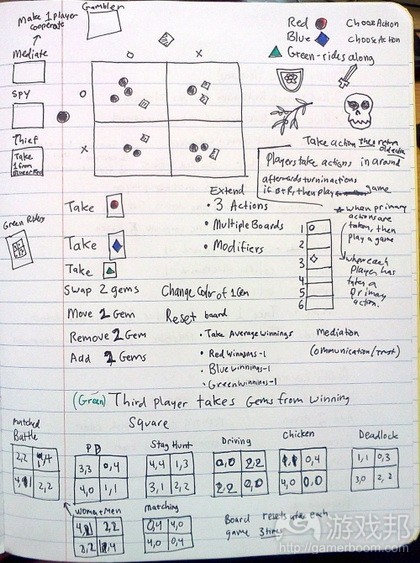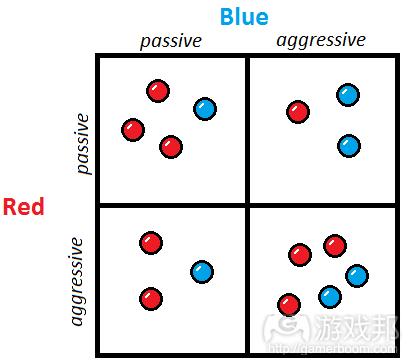从数学、艺术角度解析游戏设计之游戏机制(2)
作者:RealLifeArtist
从根本来说,游戏是由若干试图完成特定目标的玩家构成的互动活动,所以进行游戏设计需要解决的两个基本问题是(请点击此外阅读本系列第1、3部分):
1. 由多少玩家能够进行游戏体验?
2. 游戏的目标是什么?
就玩家数量而言,我想你可以将游戏分成如下类型:
* 个人主义的竞争游戏——每位玩家都想要胜出,但赢家只有1位。
* 联合竞争游戏——来自2个或过个团队的玩家相互竞争,只有1个团队会胜出。
* 完全合作型游戏——玩家共同克服游戏设计固有的障碍。
我喜欢完全合作型游戏,虽然我并没有玩过很多有趣的合作型游戏。虽然我有引入若干联合建造元素,但我的游戏属于竞争类型。
关于游戏目标,最常见的模式是成为得分最高的玩家。得分可以基于现金、财产或是抽象积分。有些游戏采用这样的设计方式:玩家逐步被淘汰,最终存活的玩家就是赢家。这些游戏存在内在弊端,当玩家离开游戏后,游戏对他们来说就不再有趣。另一获胜条件也许是个球门柱——成为首个到达目的地的玩家。
不同人对于优秀作品有不同定义。在有些人看来,《大富翁》就是款很棒的游戏。但我认为如下元素构成优秀游戏作品:
* 自动平衡:如果有人处于领先位置,游戏应向其呈现更复杂的内容。同样,我们向输家通过获胜机会。
* 选择:游戏应向玩家呈现有趣且富有挑战性的决策。
* 给所有玩家带来乐趣:在赢家和输家眼中,游戏都应富有趣味。
* 重玩价值:掌握策略应花费较长时间,所以游戏反复体验起来应该富有趣味。
你多半会同意,《大富翁》缺乏这些特性。富人更富,而穷人则逐渐衰弱,进而消亡。游戏只对富人来说富有趣味,而输家则逐一被淘汰。从本质来说,游戏主要围绕掷骰子,以及在能力范围内购买尽可能多的资产,丝毫不涉及决策元素(游戏邦注:除选择要购买小狗还是帽子外)。
在深入谈论话题前,我想要呈现都对于新作品的构思草图。这只是要告诉你,虽然我在文中的观点相当有条理及颇为连贯,但构思游戏设计无需如此。
从根本来说,我的游戏由两个要素构成:
1. 玩家轮流做出战略决策,以获得分数奖励
2. 玩家修改源自战略决策的奖励
我正在构思一个看起来像是网格的简单游戏面板,其中包含红和蓝玩家的奖励,这些奖励由网格中的小标记表示。这些彩色装饰道具可以在游戏过程中进行添加、移动或移除,进而修改奖励。
红和蓝玩家会同时但秘密选择某个操作,出于简单起见,我们将操作称作“消极”和“进取”类型。各动作组合的奖励就会对应呈现。在上述情境中,假设蓝和红玩家选择“进取”操作;红会收到3个积分,而蓝则只会收到2个积分。
将游戏玩家增至2人以上,我想象第3位玩家会扮演什么角色。如果第3位玩家无法控制自己的命运,相反只是基于红和蓝玩家的操作获得奖励,会出现什么情况。我们不妨将第3位玩家称作“绿色”玩家,以小型绿色装饰道具代表他的奖励:
在红和蓝玩家采取行动后,绿色玩家将获得已知回馈——也许这会影响红和蓝玩家的决策。事情开始变得有趣!
显然玩家应该要能够替换红、蓝和绿角色,我们要允许融入更多玩家,而非仅仅是3位玩家。我们能够做到这点。但我们还需要思考如何修改游戏奖励面板。
修改游戏面板可以通过2种基本方式完成:做出细微变更,或重新设置面板。细微变更包括移动1个装饰道具,就其中两个道具进行替换,改变某个道具的颜色,添加或移除其中一个等。关于重新设置,我想到的是将若干原型情境运用至游戏中。我觉得这些非常有趣,所以我会向你呈现奖励矩阵,同时提供简要说明。此外,为将游戏的评分机制标准化,我决定将原型给予各位玩家的奖励设置为0-4之间。因此每个回合的积分奖励能够保持一致。网格各象限的数字是有序对:头1个是红色玩家的奖励,第二个是蓝色玩家的奖励。
囚徒困境
联合采取消极举措能够带来较多回馈,但各玩家难抵进攻的诱惑。而且联合消极举措会将双方玩家置于不利地位。真是进退两难!
猎鹿博弈
双方玩家将通过采用消极举措获得丰厚回馈。玩家只有在怀疑对手会采取进攻手段的情况下才会忍不住发动进攻。这和囚徒困境类似,但略有不同,因为进攻诱惑没那么强烈。
尴尬的人行道
可以将游戏想象成两个行人在人行道上相向走来。若双方都坚持到底,那么他们就得尴尬地停下脚步。如果他们双方都走向侧边,那么尴尬情况又再次出现。双方只有在某位玩家继续行走,而另一玩家走到侧边的情况下方能获得奖励。
谁是胆小者
两个人驱车前往悬崖。最后刹车的人胜出。我们可以将操作想象成“提早刹车”和“等待另一人刹车”。胆小者提早刹车,得不到任何回馈,而勇敢者将获得丰厚奖励。但如果两位玩家都等候另一人先刹车,那么他们就会掉落悬崖,彼此都无法获得奖励。
我还构思出其他原型情境,各情境都包含不同心理学特征及策略。我将游戏的整体结构构想成:
面板由基本原型情境入手,玩家修改奖励;红和蓝玩家选择操作,然后获得积分。在面板重置成新的游戏模型前,这一过程持续重复。将绿色道具投掷至面板中,我们因此能够随机将它们放置于面板上。这可以通过提供绿色道具陈列的纸牌完成,或者可以通过掷骰子随机完成。这不太重要,无需现在做出决定。
我想要采用的游戏机制是有限操作(Limited Actions)和刺激不受欢迎的操作(Unpopular-Action Sweeteners)。
有限操作
这不是原始构思;这之前曾出现在《Agricola》、《Puerto Rico》、《Citadels》和《Meuterer》之类的杰作中。从根本来说,玩家被赋予有限操作(游戏邦注:没有两位玩家能够在一个游戏回合中采取相同的操作)。
刺激不受欢迎的操作
我玩过的有些游戏就是采用这一机制。如果没有玩家在游戏回合中采取某一操作,那么操作就会因附带奖励而变得颇有诱惑,促使下个玩家采取这一举措。每次当依然没有玩家采取这一举措时,另一奖励就会附着其中。这样所有操作都会在不同时间都富有吸引力,玩家就需要判断什么时候非战略举措变得颇具吸引力,值得他们执行。
在我看来,采用先前的游戏机制没有什么不妥。要制作出各方面都保持创新的作品很有难度。但我认为在游戏中进行创新非常重要:也许是植入可靠的机制,或者也许是创造新鲜内容。修改奖励机制我之前没有见过,所以我对此非常感兴趣。(本文为游戏邦/gamerboom.com编译,拒绝任何不保留版权的转载,如需转载请联系:游戏邦)
Math, Art, and Game Design Part 2: The Game Mechanics
by RealLifeArtist
At its core, a game is a an interaction comprising a certain number of players who are trying to reach some sort of goal, so two fundamental questions to answer about your game design are:
1. How many players can play?
2. What is the goal of the game?
As far as the number of players goes, I suppose you can classify games as:
* Individualistic competitive games – each player is trying to win, and there is only one winner.
* Coalition competitive games – players form 2 or more teams which they compete, one team being the winner
* Fully cooperative games – the players all work together to overcome some obstacle inherent in the design of the game.
I love the idea of fully cooperative games, although I haven’t played many fun cooperative games. And though I may include some aspects of coalition-building, my game is going to be strictly competitive.
With regards to the game’s goal, I’d say the most common goal is to simply get the highest score of all players. Score could be based on cash, property, or just simply abstract points. Other games are designed such that players are eliminated as the game goes on with the winner being the last remaining player. These games have an inherent drawback in that the game ceases to be fun for a player once he is out of the game. Another winning condition could be a goalpost – a race to be the first to reach some milestone (this could be a certain number of points, for example).
Different people have different qualities they look for in a good game. For some people, Monopoly is a wonderful game. However, I’d posit that these are the qualities of a good game:
* Self-Balancing: If someone is in the lead the game should be harder for him. Likewise, we want opportunities for underdogs to triumph.
* Choices: The game should present players with interesting and challenging decisions to make.
* Fun for All: The game should be as fun for the winner(s) as it is for the loser(s).
* Replay Value: Mastering the strategy should take a long time (if possible at all), so the game is fun to play over and over again.
Hopefully you agree that Monopoly has NONE of these qualities. The rich get richer in while the poor wither and die. The game is only fun for the rich, while the losers are eliminated one by one. The game is, in essence, rolling dice and buying as much property as you can afford with almost no decision-making – besides choosing whether to be the doggie or the hat. (Obviously you want to be the battleship! It has guns, duh! And if you go broke you can sell it for millions of dollars!)
Before going any further, I want to show you a page from my brainstorming for my new game. This is just to show you that although my thoughts in this article are relatively organized and coherent, brainstorming the design of a game does not have to be!
Essentially my game consists of two aspects:
1. Players take turns making strategic choices to receive scored rewards, and
2. Players modify rewards that result from strategic choices.
I’m imagining a simple game board that looks like a grid, with Red’s and Blue’s rewards represented by little markers within the grid. These colored baubles can be added, moved or removed during the game to modify rewards.
Red and Blue simultaneously but secretly choose an action each, of two that I will call “passive” and “aggressive” for simplicity’s sake. The reward for each combination of actions is then doled out accordingly. In the above scenario, let’s say both Blue and Red choose the “aggressive” action; Red will receive 3 points and Blue 2.
To extend this type of game to more than two players, I imagined what role a third player might take. What if the third player did not have control of his own fate, but instead just received a reward based on the actions of players Red and Blue. Let’s call the third player “Green” and show his rewards with little green baubles:
After Red and Blue take actions, green is rewarded with known rewards – perhaps this will influence the decisions of Red and Blue. Things are starting to get interesting!
Clearly the players should have some sort of way of alternating who gets to be Red, Blue and Green… and we should extend this to allow for more players than just three. Sure – we’ll get to that. But we also have to think about how to modify the rewards game board.
Modifying the game board could be done in one of two basic ways: with small changes or by resetting the board. Small changes consist of moving one bauble, swapping two, changing the color of one, adding or removing one, etc. For resetting the board I thought of applying some archetypal scenarios to the game. Because I think these are interesting I’ll show you the reward matrix while providing a brief description. Also, to normalize the scoring of the game, I decided that these archetypes will have rewards ranging from 0 to 4 for each player. Thus we can expect points awarded each round to be roughly in the same ballpark. The numbers in each quadrant of the grid are ordered pairs: the first is Red’s reward, and the second Blue’s reward.
Prisoner’s Dilemma
Joint passivity is highly rewarding, but each player has a temptation for aggression. However, joint aggression puts both players at a disadvantage. What a dilemma!
Stag Hunt
Both players are highly rewarded for passivity. Players are only tempted towards aggression if they suspect their opponent will do the same. This is similar to the prisoner’s dilemma but slightly different because the temptation towards aggression is not as strong.
Awkward Sidewalk
This game can be thought of as two people walking towards each other on the sidewalk. If they both stay the course then they have to stop awkwardly. If they both step to the side then it’s awkward again. Both players are only rewarded if one keeps walking while the other steps to the side.
Chicken
Two people drive their cars towards a cliff. The last person to brake wins. The actions can be thought of “brake early” and “wait for the other person to brake”. The chicken brakes early and gets nothing (just shame) while the brave one gets a big reward (fame and praise). But if both players wait for the other to brake then they both drive off the cliff, and neither gets a reward.
There are other archetypal scenarios that I’ve identified and would like to include, each with a different psychological profile and strategy set for the players. I imagine the overall structure of my game is this:
The board starts with a basic archetypal scenario, and the players modify rewards; Red and Blue choose actions, then points are scored. This is repeated twice more before the board is reset to a new game archetype. To throw Green’s baubles onto the board, we can have some way to somewhat randomly place them on the board. This could be done with a deck of cards that provide layouts of the green baubles, or it could be done randomly by rolling dice. That’s not too important to decide right now.
The game mechanics that I want to employ (and discuss just a little bit) are Limited Actions and Unpopular-Action Sweeteners.
Limited Actions
This is not an original concept really; it’s certainly been done before in many cool games such as Agricola, Puerto Rico, Citadels, and Meuterer (to name a few). Basically the players are presented with a limited set of actions and no two players are able to take the same action during a game round.
Unpopular-Action Sweeteners
A few games I’ve played employ something to this effect. If nobody takes an action during one round or turn, then the action is sweetened by placing a reward on it, to be received by the next player to choose that action. Every round that nobody takes the action another reward is placed on it. This way all actions will be attractive at different times and players have to decide at what point a non-strategic action has been sweetened enough to make it worthwhile.
I think it’s fine to employ game mechanics that have been done before. It would be extremely difficult to make a GOOD game that is original in all respects. However, I think it is important to do something novel in your game: perhaps the interaction of tried-and-true mechanics, or perhaps inventing something new. The modification of rewards is something I haven’t seen before, so I’m interested to see where this goes.
Without boring you with TOO many details of my brainstorming, I would say that I’m about ready to put together a rough prototype of the game and start testing it out in practice!(Source:reallifeartist)












































